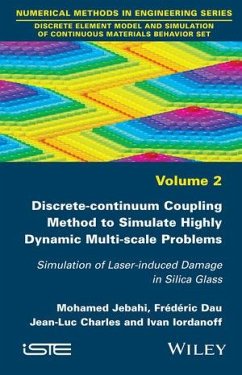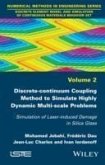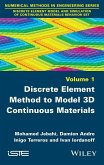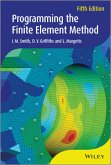Mohamed Jebahi, Frédéric Dau, Jean-Luc Charles, Ivan Iordanoff
Discrete-continuum Coupling Method to Simulate Highly Dynamic Multi-scale Problems (eBook, ePUB)
Simulation of Laser-induced Damage in Silica Glass, Volume 2
139,99 €
139,99 €
inkl. MwSt.
Sofort per Download lieferbar

0 °P sammeln
139,99 €
Als Download kaufen

139,99 €
inkl. MwSt.
Sofort per Download lieferbar

0 °P sammeln
Jetzt verschenken
Alle Infos zum eBook verschenken
139,99 €
inkl. MwSt.
Sofort per Download lieferbar
Alle Infos zum eBook verschenken

0 °P sammeln
Mohamed Jebahi, Frédéric Dau, Jean-Luc Charles, Ivan Iordanoff
Discrete-continuum Coupling Method to Simulate Highly Dynamic Multi-scale Problems (eBook, ePUB)
Simulation of Laser-induced Damage in Silica Glass, Volume 2
- Format: ePub
- Merkliste
- Auf die Merkliste
- Bewerten Bewerten
- Teilen
- Produkt teilen
- Produkterinnerung
- Produkterinnerung

Bitte loggen Sie sich zunächst in Ihr Kundenkonto ein oder registrieren Sie sich bei
bücher.de, um das eBook-Abo tolino select nutzen zu können.
Hier können Sie sich einloggen
Hier können Sie sich einloggen
Sie sind bereits eingeloggt. Klicken Sie auf 2. tolino select Abo, um fortzufahren.

Bitte loggen Sie sich zunächst in Ihr Kundenkonto ein oder registrieren Sie sich bei bücher.de, um das eBook-Abo tolino select nutzen zu können.
Complex behavior models (plasticity, crack, visco-elascticity) are facing several theoretical difficulties in determining the behavior law at the continuous (macroscopic) scale. When homogenization fails to give the right behavior law, a solution is to simulate the material at a mesoscale using the discrete element model (DEM) in order to directly simulate a set of discrete properties that are responsible for the macroscopic behavior. Originally, the discrete element model was developed for granular material. This book, the second in the Discrete Element Model and Simulation of Continuous…mehr
- Geräte: eReader
- mit Kopierschutz
- eBook Hilfe
- Größe: 8.5MB
Andere Kunden interessierten sich auch für
![Discrete-continuum Coupling Method to Simulate Highly Dynamic Multi-scale Problems (eBook, PDF) Discrete-continuum Coupling Method to Simulate Highly Dynamic Multi-scale Problems (eBook, PDF)]() Mohamed JebahiDiscrete-continuum Coupling Method to Simulate Highly Dynamic Multi-scale Problems (eBook, PDF)139,99 €
Mohamed JebahiDiscrete-continuum Coupling Method to Simulate Highly Dynamic Multi-scale Problems (eBook, PDF)139,99 €![3D Discrete Element Workbench for Highly Dynamic Thermo-mechanical Analysis (eBook, ePUB) 3D Discrete Element Workbench for Highly Dynamic Thermo-mechanical Analysis (eBook, ePUB)]() Damien Andre3D Discrete Element Workbench for Highly Dynamic Thermo-mechanical Analysis (eBook, ePUB)139,99 €
Damien Andre3D Discrete Element Workbench for Highly Dynamic Thermo-mechanical Analysis (eBook, ePUB)139,99 €![Discrete Element Method to Model 3D Continuous Materials (eBook, ePUB) Discrete Element Method to Model 3D Continuous Materials (eBook, ePUB)]() Mohamed JebahiDiscrete Element Method to Model 3D Continuous Materials (eBook, ePUB)139,99 €
Mohamed JebahiDiscrete Element Method to Model 3D Continuous Materials (eBook, ePUB)139,99 €![Large and Middle-scale Aperture Aspheric Surfaces (eBook, ePUB) Large and Middle-scale Aperture Aspheric Surfaces (eBook, ePUB)]() Shengyi LiLarge and Middle-scale Aperture Aspheric Surfaces (eBook, ePUB)151,99 €
Shengyi LiLarge and Middle-scale Aperture Aspheric Surfaces (eBook, ePUB)151,99 €![Programming the Finite Element Method (eBook, ePUB) Programming the Finite Element Method (eBook, ePUB)]() I. M. SmithProgramming the Finite Element Method (eBook, ePUB)94,99 €
I. M. SmithProgramming the Finite Element Method (eBook, ePUB)94,99 €![Acoustic Emission and Related Non-destructive Evaluation Techniques in the Fracture Mechanics of Concrete (eBook, ePUB) Acoustic Emission and Related Non-destructive Evaluation Techniques in the Fracture Mechanics of Concrete (eBook, ePUB)]() Acoustic Emission and Related Non-destructive Evaluation Techniques in the Fracture Mechanics of Concrete (eBook, ePUB)149,95 €
Acoustic Emission and Related Non-destructive Evaluation Techniques in the Fracture Mechanics of Concrete (eBook, ePUB)149,95 €![Up and Running with AutoCAD 2014 (eBook, ePUB) Up and Running with AutoCAD 2014 (eBook, ePUB)]() Elliot J. GindisUp and Running with AutoCAD 2014 (eBook, ePUB)49,95 €
Elliot J. GindisUp and Running with AutoCAD 2014 (eBook, ePUB)49,95 €-
-
-
Complex behavior models (plasticity, crack, visco-elascticity) are facing several theoretical difficulties in determining the behavior law at the continuous (macroscopic) scale. When homogenization fails to give the right behavior law, a solution is to simulate the material at a mesoscale using the discrete element model (DEM) in order to directly simulate a set of discrete properties that are responsible for the macroscopic behavior. Originally, the discrete element model was developed for granular material. This book, the second in the Discrete Element Model and Simulation of Continuous Materials Behavior set of books, shows how to choose the adequate coupling parameters to avoid spurious wave reflection and to allow the passage of all the dynamic information both from the fine to the coarse model and vice versa. The authors demonstrate the coupling method to simulate a highly nonlinear dynamical problem: the laser shock processing of silica glass.
Dieser Download kann aus rechtlichen Gründen nur mit Rechnungsadresse in D ausgeliefert werden.
Produktdetails
- Produktdetails
- Verlag: John Wiley & Sons
- Erscheinungstermin: 2. Oktober 2015
- Englisch
- ISBN-13: 9781119119289
- Artikelnr.: 43982014
- Verlag: John Wiley & Sons
- Erscheinungstermin: 2. Oktober 2015
- Englisch
- ISBN-13: 9781119119289
- Artikelnr.: 43982014
- Herstellerkennzeichnung Die Herstellerinformationen sind derzeit nicht verfügbar.
Mohamed Jebahi is a post-doctoral researcher at the Institute of Mechanics and Engineering of Bordeaux, France, and Laval University, Quebec, Canada.
Frédéric Dau is Assistant Professor at Ecole Nationale Supérieure d'Arts et Métiers, ParisTech, France.
Jean-Luc Charles is Assistant Professor at Ecole Nationale Supérieure d'Arts et Métiers, ParisTech, France.
Ivan Iordanoff is Director of Research and Innovation at Ecole Nationale Supérieure d'Arts et Métiers, ParisTech, France.
Frédéric Dau is Assistant Professor at Ecole Nationale Supérieure d'Arts et Métiers, ParisTech, France.
Jean-Luc Charles is Assistant Professor at Ecole Nationale Supérieure d'Arts et Métiers, ParisTech, France.
Ivan Iordanoff is Director of Research and Innovation at Ecole Nationale Supérieure d'Arts et Métiers, ParisTech, France.
List of Figures ix List of Tables xv Preface xvii Introduction xix Part 1. Discrete-Continuum Coupling Method to Model Highly Dynamic Multi-Scale Problems 1 Chapter 1. State of the Art: Concurrent Discrete-continuum Coupling 3 1.1. Introduction 3 1.2. Coupling challenges 4 1.2.1. Dissimilar variables due to different mechanical bases 4 1.2.2. Wave reflections due to different analysis scales 4 1.3. Coupling techniques 10 1.3.1. Edge-to-edge coupling methods 11 1.3.2. Bridging domain coupling methods 15 1.3.3. Bridging-scale coupling methods 19 1.3.4. Other coupling techniques 23 1.4. Conclusion 25 Chapter 2. Choice of the Continuum Method to be Coupled with the Discrete Element Method 27 2.1. Introduction 27 2.2. Classification of the continuum methods 28 2.2.1. Grid-based methods 28 2.2.2. Meshless methods 33 2.3. Choice of continuum method 38 2.4. The constrained natural element method 41 2.4.1. Natural neighbor interpolation 41 2.4.2. Visibility criterion 48 2.4.3. Constrained natural neighbor interpolation 48 2.4.4. Numerical integration 49 2.5. Conclusion 51 Chapter 3. Development of Discrete-Continuum Coupling Method Between DEM and CNEM 53 3.1. Introduction 53 3.2. Discrete-continuum coupling method: DEM-CNEM 54 3.2.1. DEM-CNEM coupling formulation 54 3.2.2. Discretization and spatial integration 59 3.2.3. Time integration 62 3.2.4. Algorithmic 63 3.2.5. Implementation 66 3.3. Parametric study of the coupling parameters 67 3.3.1. Influence of the junction parameter l 71 3.3.2. Influence of the weight function
73 3.3.3. Influence of the approximated mediator spaceM
79 3.3.4. Influence of the width of the bridging zone LB 79 3.3.5. Dependence between LB andM
81 3.4. Choice of the coupling parameters in practice 83 3.5. Validation 84 3.6. Conclusion 85 Part 2. Application: Simulation of Laser Shock Processing of Silica Glass 89 Chapter 4. Some Fundamental Concepts in Laser Shock Processing 91 4.1. Introduction 91 4.2. Theory of laser-matter interaction: high pressure generation 92 4.2.1. Generation of shock wave by laser ablation 93 4.2.2. Shock wave propagation in materials 96 4.2.3. Laser-induced damage in materials 106 4.3. Mechanical response of silica glass under high pressure 109 4.3.1. Silica glass response under quasi-static hydrostatic compression 109 4.3.2. Silica glass response under shock compression 114 4.3.3. Summary of the silica glass response under high pressure 118 4.4. Conclusion 119 Chapter 5. Modeling of the Silica Glass Mechanical Behavior 121 5.1. Introduction 121 5.2. Mechanical behavior modeling 122 5.2.1. Modeling assumption 123 5.2.2. Cohesive beam model 124 5.2.3. Quasi-static calibration and validation 127 5.2.4. Dynamic calibration and validation 139 5.3. Brittle fracture modeling 147 5.4. Conclusion 149 Chapter 6. Simulation of Laser Shock Processing of Silica Glass 151 6.1. Introduction 151 6.2. LSP test 153 6.3. LSP model 155 6.4. Results 159 6.5. Conclusion 163 Conclusion 165 Bibliography 171 Index 185
73 3.3.3. Influence of the approximated mediator spaceM
79 3.3.4. Influence of the width of the bridging zone LB 79 3.3.5. Dependence between LB andM
81 3.4. Choice of the coupling parameters in practice 83 3.5. Validation 84 3.6. Conclusion 85 Part 2. Application: Simulation of Laser Shock Processing of Silica Glass 89 Chapter 4. Some Fundamental Concepts in Laser Shock Processing 91 4.1. Introduction 91 4.2. Theory of laser-matter interaction: high pressure generation 92 4.2.1. Generation of shock wave by laser ablation 93 4.2.2. Shock wave propagation in materials 96 4.2.3. Laser-induced damage in materials 106 4.3. Mechanical response of silica glass under high pressure 109 4.3.1. Silica glass response under quasi-static hydrostatic compression 109 4.3.2. Silica glass response under shock compression 114 4.3.3. Summary of the silica glass response under high pressure 118 4.4. Conclusion 119 Chapter 5. Modeling of the Silica Glass Mechanical Behavior 121 5.1. Introduction 121 5.2. Mechanical behavior modeling 122 5.2.1. Modeling assumption 123 5.2.2. Cohesive beam model 124 5.2.3. Quasi-static calibration and validation 127 5.2.4. Dynamic calibration and validation 139 5.3. Brittle fracture modeling 147 5.4. Conclusion 149 Chapter 6. Simulation of Laser Shock Processing of Silica Glass 151 6.1. Introduction 151 6.2. LSP test 153 6.3. LSP model 155 6.4. Results 159 6.5. Conclusion 163 Conclusion 165 Bibliography 171 Index 185
List of Figures ix List of Tables xv Preface xvii Introduction xix Part 1. Discrete-Continuum Coupling Method to Model Highly Dynamic Multi-Scale Problems 1 Chapter 1. State of the Art: Concurrent Discrete-continuum Coupling 3 1.1. Introduction 3 1.2. Coupling challenges 4 1.2.1. Dissimilar variables due to different mechanical bases 4 1.2.2. Wave reflections due to different analysis scales 4 1.3. Coupling techniques 10 1.3.1. Edge-to-edge coupling methods 11 1.3.2. Bridging domain coupling methods 15 1.3.3. Bridging-scale coupling methods 19 1.3.4. Other coupling techniques 23 1.4. Conclusion 25 Chapter 2. Choice of the Continuum Method to be Coupled with the Discrete Element Method 27 2.1. Introduction 27 2.2. Classification of the continuum methods 28 2.2.1. Grid-based methods 28 2.2.2. Meshless methods 33 2.3. Choice of continuum method 38 2.4. The constrained natural element method 41 2.4.1. Natural neighbor interpolation 41 2.4.2. Visibility criterion 48 2.4.3. Constrained natural neighbor interpolation 48 2.4.4. Numerical integration 49 2.5. Conclusion 51 Chapter 3. Development of Discrete-Continuum Coupling Method Between DEM and CNEM 53 3.1. Introduction 53 3.2. Discrete-continuum coupling method: DEM-CNEM 54 3.2.1. DEM-CNEM coupling formulation 54 3.2.2. Discretization and spatial integration 59 3.2.3. Time integration 62 3.2.4. Algorithmic 63 3.2.5. Implementation 66 3.3. Parametric study of the coupling parameters 67 3.3.1. Influence of the junction parameter l 71 3.3.2. Influence of the weight function
73 3.3.3. Influence of the approximated mediator spaceM
79 3.3.4. Influence of the width of the bridging zone LB 79 3.3.5. Dependence between LB andM
81 3.4. Choice of the coupling parameters in practice 83 3.5. Validation 84 3.6. Conclusion 85 Part 2. Application: Simulation of Laser Shock Processing of Silica Glass 89 Chapter 4. Some Fundamental Concepts in Laser Shock Processing 91 4.1. Introduction 91 4.2. Theory of laser-matter interaction: high pressure generation 92 4.2.1. Generation of shock wave by laser ablation 93 4.2.2. Shock wave propagation in materials 96 4.2.3. Laser-induced damage in materials 106 4.3. Mechanical response of silica glass under high pressure 109 4.3.1. Silica glass response under quasi-static hydrostatic compression 109 4.3.2. Silica glass response under shock compression 114 4.3.3. Summary of the silica glass response under high pressure 118 4.4. Conclusion 119 Chapter 5. Modeling of the Silica Glass Mechanical Behavior 121 5.1. Introduction 121 5.2. Mechanical behavior modeling 122 5.2.1. Modeling assumption 123 5.2.2. Cohesive beam model 124 5.2.3. Quasi-static calibration and validation 127 5.2.4. Dynamic calibration and validation 139 5.3. Brittle fracture modeling 147 5.4. Conclusion 149 Chapter 6. Simulation of Laser Shock Processing of Silica Glass 151 6.1. Introduction 151 6.2. LSP test 153 6.3. LSP model 155 6.4. Results 159 6.5. Conclusion 163 Conclusion 165 Bibliography 171 Index 185
73 3.3.3. Influence of the approximated mediator spaceM
79 3.3.4. Influence of the width of the bridging zone LB 79 3.3.5. Dependence between LB andM
81 3.4. Choice of the coupling parameters in practice 83 3.5. Validation 84 3.6. Conclusion 85 Part 2. Application: Simulation of Laser Shock Processing of Silica Glass 89 Chapter 4. Some Fundamental Concepts in Laser Shock Processing 91 4.1. Introduction 91 4.2. Theory of laser-matter interaction: high pressure generation 92 4.2.1. Generation of shock wave by laser ablation 93 4.2.2. Shock wave propagation in materials 96 4.2.3. Laser-induced damage in materials 106 4.3. Mechanical response of silica glass under high pressure 109 4.3.1. Silica glass response under quasi-static hydrostatic compression 109 4.3.2. Silica glass response under shock compression 114 4.3.3. Summary of the silica glass response under high pressure 118 4.4. Conclusion 119 Chapter 5. Modeling of the Silica Glass Mechanical Behavior 121 5.1. Introduction 121 5.2. Mechanical behavior modeling 122 5.2.1. Modeling assumption 123 5.2.2. Cohesive beam model 124 5.2.3. Quasi-static calibration and validation 127 5.2.4. Dynamic calibration and validation 139 5.3. Brittle fracture modeling 147 5.4. Conclusion 149 Chapter 6. Simulation of Laser Shock Processing of Silica Glass 151 6.1. Introduction 151 6.2. LSP test 153 6.3. LSP model 155 6.4. Results 159 6.5. Conclusion 163 Conclusion 165 Bibliography 171 Index 185







